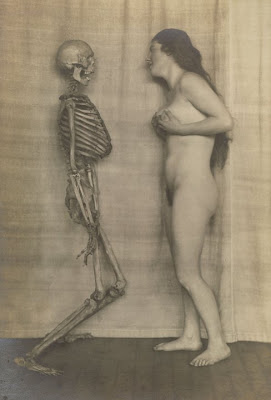
O Krampus είναι ένας μυθικός δαίμονας των Αλπικών περιοχών που συνοδεύει τον Αγιο Νικόλαο, ο οποίος ελέγχει τα παιδιά αν είναι «καλά» ή «κακά». Αν θεωρήσει ότι είναι καλά και υπάκουα τα γεμίζει δώρα, αν όμως κρίνει ότι έιναι άτακτα και κακά, τότε τα παραδίδει χωρίς κανένα έλεος στον δαίμονα, ο οποίος θα τα υποβάλει σε σκληρή και παραδειγματική τιμωρία, για να πάρουν μια γεύση από τι τα περιμένει στην Κόλαση, αν δεν ακολουθούν το δρόμο της αρετής και της χριστιανικής πίστης. Όλα αυτά διαδίδονται στα παιδιά τις παραμονές του Αγίου Νικολάου (5 Δεκεμβρίου), όταν οι γονείς τα βάζουν για ύπνο και η τελική κρίση την ημέρα της γιορτής του (6 Δεκεμβρίου), όταν θα βρουν πάνω στα παπούτσια τους, είτε δώρα (του Αγίου Νικολάου), είτε βέργες για να φάνε ξύλο, κάρβουνα ή σάπια λαχανικά (του Krampus απειλές)
Στην περιοχή της Αυστρίας, την παραμονή του Αγίου Νικολάου, νεαροί ντύνονται σαν φριχτοί δαίμονες με αλυσίδες και κουδούνες και περιφέρονται στους δρόμους τρομάζοντας υποτίθεται τα παιδιά.



Krampus is a mythical creature recognized in alpine countries. He is a bound devil who escorts the benevolent Saint Nicholas on the eve of his day Saint Nicholas tests the children with their Catechism and good behavior. If they pass he gives gifts and treats. If they fail, Krampus is set loose to deal with these bad children; worse than lumps of coal & rotten potatoes, he may also use a switch of twigs to beat them and molests the bad children in other ways… giving them a taste of Hell to come. On the eve of Saint Nichola’s Day (December 5th) children are put to bed and warned of their peril. They may avoid a direct visit by leaving shoes outside the door. If they sleep soundly, they will not have to deal with the test, and in the morning of St Nichola’s Day (December 6th) they will find either treats & small gifts in their shoes, or a switch, lump of coal, or rotten potatoes. Parents are expected to use the switch on those children so designated as having been really bad. Perhaps they can heed the warning and behave better until Christmas when the Christ child brings gifts. (
sarcofaga chronicles)
In the Alpine regions, Krampus is represented by a demon-like creature. Traditionally, young men dress up as the Krampus in Austria during the first two weeks of December, particularly on the evening of 5 December, and roam the streets frightening children with rusty chains and bells. (
Wikipedia)










 Der Orchideengarten ('Garden of Orchids'; subtitled Phantastische Blatter or 'Fantastic Pages') was a Munich, German magazine that appeared for 51 issues from January, 1919 until November, 1921. Founded four years before the American magazine Weird Tales was launched in March 1923, it is hailed as the first fantasy magazine. Also described as largely 'supernatural horror', it was edited by World War I correspondent and freelance writer Karl Hans Strobl and Alfons von Czibulka, published by Drerlanderverlag. It had 24 pages per issue printed on rough book paper.
Der Orchideengarten ('Garden of Orchids'; subtitled Phantastische Blatter or 'Fantastic Pages') was a Munich, German magazine that appeared for 51 issues from January, 1919 until November, 1921. Founded four years before the American magazine Weird Tales was launched in March 1923, it is hailed as the first fantasy magazine. Also described as largely 'supernatural horror', it was edited by World War I correspondent and freelance writer Karl Hans Strobl and Alfons von Czibulka, published by Drerlanderverlag. It had 24 pages per issue printed on rough book paper. The magazine included a wide selection of fantastic stories by famous foreign authors such as Dickens, Pushkin, Charles Nodier, Maupassant, Poe, Voltaire, Gautier, Washington Irving, Hawthorne, H. G. Wells, Victor Hugo, and Karel and Josef Capek. German language writers for the magazine included Strobl, H.H. Schmizt and Leo Perutz. Illustrations included works by Gustave Dore, Tony Johannot, Rolf von Hoerschelmann, Otto Linnekogel, Karl Ritter, Heinrich Kley, and Alfred Kubin. (wikipedia)
The magazine included a wide selection of fantastic stories by famous foreign authors such as Dickens, Pushkin, Charles Nodier, Maupassant, Poe, Voltaire, Gautier, Washington Irving, Hawthorne, H. G. Wells, Victor Hugo, and Karel and Josef Capek. German language writers for the magazine included Strobl, H.H. Schmizt and Leo Perutz. Illustrations included works by Gustave Dore, Tony Johannot, Rolf von Hoerschelmann, Otto Linnekogel, Karl Ritter, Heinrich Kley, and Alfred Kubin. (wikipedia)














































